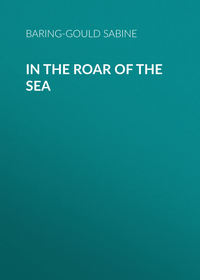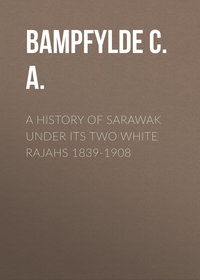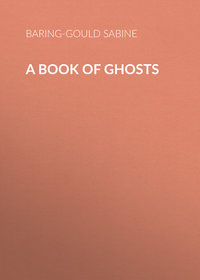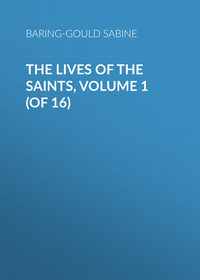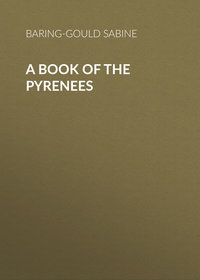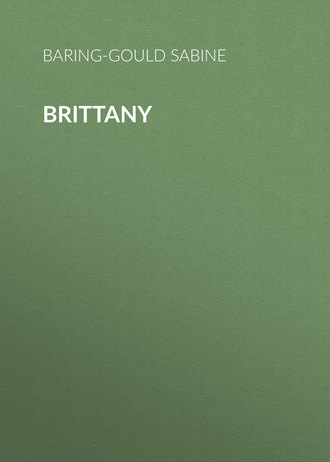 полная версия
полная версияBrittany
At Primel is a chapel of the 15th cent. A calvary is in the parish churchyard.
At Etrelles the church is of the beginning of the 16th cent.
Arzano (F.) chl. arr. Quimperlé. An uninteresting place, but some pretty scenery on the Ellé and Isole. The neighbourhood is best visited from Quimperlé.
* AUDIERNE (F.) a com. of Pontcroix. A large fishing village, at the mouth of a tidal creek, into which flows the insignificant Goujen. The entrance to the harbour is dangerous. The river front of the village or town is occupied almost wholly by buvettes. Sardines are here tinned. The church, originally dedicated to S. Rumon, the same as S. Ronan, has been transferred to the patronage of S. Raymond Nonnatus. It is well-situated, and of renaissance period, but has preserved an earlier internal arcade. The south porch is of the usual 16th cent. type in Lower Brittany, but with renaissance details. Ships are carved over the church. The tower with gallery is mean. A curious recess with stoup outside the W. end, with broken circle above it. An old house in the street bears the date 1668. Audierne swarms with children who pester the visitor with begging. It is an unattractive place, but has good inns, and forms a centre for an interesting district. See also Pont Croix.
At Primelin is the Chapel of S. Tugean (a Saint Antianus) in a hamlet, surrounded with trees. It is a noble structure throughout, in the flamboyant style. A noble south porch with statues within of six apostles. The tower without spire is early flamboyant, and has a curious side turret with spire. The W. doorway is good with the four doctors of the church above it. The N. transept is double, divided by round pillars surmounted by Doric capitals. The carved wood roof of the chancel and N. transept deserve notice. Rich rococo altarpieces. Paintings (1705) about the baptistery. A good statue of S. Tugean represents him with a mad dog on one side and a boy kneeling on the other. The Saint is patron against hydrophobia. Outside the chapel is a cell into which were thrust those who had been bitten, and were not cured. They were communicated with the Host, thrust to them at the end of a stick, and there left to die. S. Tugean's key is preserved in the church. The P. on the last Sunday in June is very famous. Near the windmill is a small dolmen, or rather a kistvaen, the cover of which has been lifted and propped on small stones. This was used by lepers to lie in, expecting a cure.
Plogoff has a church of the 16th cent., but possesses remains of an earlier period, pillars with Romanesque capitals. The Chapel of S. Collodec (Kenan, B. of Duleek) has a pretty spire, and a carved granite cross. P. 1st Sunday in July. The Pardon at the Chapel of N.D. de Bon Voyage is on the 3rd Sunday in July. The Enfer de Plogoff is a chasm into which the sea enters. The Pointe du Raz rises 240 feet above the sea, which is here rarely at rest. It commands a fine view of the stretch of coast from the Pointe to S. Mathieu on the north, and to Penmarch on the south. The Ile de Seine lies nine miles away to sea, west of the Pointe du Raz, the passage is dangerous on account of the currents. It possesses little to attract a visitor, a couple of menhirs, called the Fistillerien or the Gossips, and a dolmen.
The Baie des Trépassés takes its name from the number of dead bodies washed ashore in it after a wreck. A Byzantine writer speaks of this bay and tells a curious story about it. He says that here the boatman was called up at the dead of night to convey passengers to the Ile de Seine. He took his oars and launched his boat, and heard a sound as of people entering his barque, but saw no one. The boat settled deep in the water, and he rowed over with his invisible burden. On reaching the Isle of Seine, he could hear the passengers disembark, and coins were cast to him, but still those whom he had ferried over remained invisible. He had, in fact, conveyed the souls of the dead to the Isle of the Dead. And this strange occurrence took place repeatedly.
The Etang de Laoual is supposed to cover the cursed city of Is, where Ahes, daughter of King Grallo, carried on high revelry and debauch. The wrath of heaven was kindled, and the sea overwhelmed the city. Remains of a Roman city remain at Troguer, and this was the termination of the Roman road from Carhaix (Vorganium). At the Chapel of S. They (the Cornish S. Day) the P. is on the 1st Sunday in July.
Cleden-Cap-Sizun. The coast here is bold, and there are numerous prehistoric monuments. At Goulien is a menhir 18 ft. high, and there are remains of a Roman camp.
Beuzec-Cap-Sizun. The church (S. Budoc) has a fine 16th cent. tower. Near the hamlet of Kerbanalec is an allée couverte. The holy well of Ste. Azenora (the Cornish Sennara), mother of S. Budoc, is supposed to have the peculiarity of filling with milk the breasts of any man who drinks thereof. Mothers nursing their children frequent it. P. at N.D. de la Clarté on the Sunday after the 15th August.
* AURAY (M.) chl. arr. Lorient. On a height above the river of Auray and the harbour. The river is a tidal creek, very unsavoury when in flow or when left dry. A large export of pine logs takes place hence to Cardiff for the mines. There are several old houses in the town, especially by the bridge. The halles have a vast roof on bold timber work. The Church of S. Gildas was built in 1636, and is utterly Italian, except for the vaulting. The south entrance is not without merit. The Church of S. Goustan dates from the 16th century. In the chapel of the Pêre Eternel is rich carved stall work derived from the Chartreuse.
Within an easy stroll from Auray is the Chapel de Ste. Avoye. Here, according to legend, the Saint, who is the same as the Cornish S. Ewe, arrived in a stone boat from Britain. The chapel is surrounded by a few farmhouses and trees. It is a renaissance structure. The W. tower consists of only three sides, two bold buttresses carried up a great height, with a back, sustaining a pent-house roof, which in turn supports a spirelet of slate. The arrangement is probably unique. There was a porch below, but it has fallen. The tracery has been removed from the windows, and some good stained glass sold. Within is a fine but late screen with the twelve apostles on one side and cardinal virtues and other allegorical figures on the other. In the nave is a piece of the so-called "boat of S. Avoye," in which she is supposed to have come over. Actually it is, probably, a large grinder for corn polished within. On it are cut three symbols, one a cross, one like a T, and the third like I. Children that are delicate are placed in the "Boat" to recover strength. Over the altar is a painting representing S. Avoye in prison fed by the B. V. Mary. There are two Pardons, the principal on the 1st S. in May, the second on the 3rd S. in September. Outside the chapel are stone benches along the wall. In Breton the Saint is Santez Avé.
Ste. Anne d'Auray is a great pilgrimage resort, with a pretentious modern church in nondescript style intended for renaissance, 1866-75, with bad glass. In 1623 a peasant dug up an image, probably of one of the Deæ Matres of Gallo-Roman times, so common in Brittany, at a place called Ker-anna. He jumped to the conclusion that it represented the mother of the B. Virgin. The Carmelites heard of it and resolved on making capital out of it; they ran it with great success and built a convent and church on the spot in 1645. The statue was destroyed in 1790, but the cult continues unabated. The Pardon is on the Sunday after July 26, and attracts vast crowds. In front of the church is a Santa Scala copied from that at Rome, and indulgenced with nine years for every step ascended by pilgrims on their knees. A large tank receives the miraculous spring of S. Anne, and is dominated by her statue. The pilgrims sing lustily the cantique of Ste. Anne d'Auray to this air: —
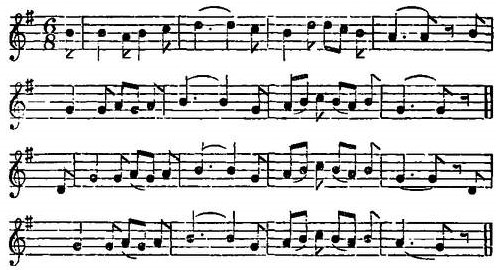
There is here a statue of the Duc de Chambord (1891) in bronze, flanked by those of Bayard, Du Guesclin, Ste. Geneviève, and Joan of Arc.
The Chartreuse near the Auray railway station is now a deaf and dumb asylum. It occupies the site of the battle in which, in 1364, Jean de Monfort defeated and killed Charles de Blois. He founded the monastery, but only a small portion of the old structure remains. Here is the chapel, on the N. side of the church, in which rest the bodies of the royalists who had been landed from English transports at Quiberon, and whom Hoche and his republican soldiers shot down in cold blood to the number of 952 between 1st and 25th August 1795. The butchery took place not far from the Chartreuse, and the bodies were buried on the spot since called le Champ des Martyrs. In 1814 they were transferred to this chapel erected to contain them. It was completed in 1829. In the midst of the chapel is the mausoleum of white marble.
The chapelle expiatoire is situated at a quarter of an hour's walk from the Chartreuse and is in the Greek style, and is on the site of the massacre. Near by is a cross commemorative of Montfort's victory over Charles de Blois.
Plougoumelin. The parish church modern and bad. The Chapel of N.D. de Becquerel has a fine west porch of the Breton commingling of flamboyant and renaissance. An unfailing spring issues from under the wall of the apse. The water is thought to cure diseases of the mouth. Several lechs are in the parish. One called the Pierre du Serment is about 4 ft. 6 in. long, is in the churchyard and lies prostrate. Another is between the parsonage and the cemetery, and a third, round, with three hollows sunk in it, is at the presbytère. A tumulus by the river of Auray at Le Rocher covers an allée couverte. There are six others, smaller, in a line with it running from S.W. to N.E. They have yielded copper vessels and flint weapons, and belong to the intermediate age, before alloy was introduced for the formation of bronze.
Crach. Here in the commune are numerous prehistoric remains. Rather over a mile from Auray on the road to Crach is a fine dolmen, the coverer 22 ft. long, and having on it a circle of hollows. Other dolmens at Keryn, Kergleverit, and Parq-er-Gueren, near the Chapel of S. Jean. Several menhirs on the common. The Château de Plessisker is of the 17th cent. P. at Crach on the 1st S. in July. See also Locmariaquer.
Bain (I.V.) chl. arr. Redon, on the Route nationale from Rennes to Nantes. In the cemetery a cross of the 16th cent. Château de la Noé of the 15th cent. By a little lake are the remains of a castle converted into a farmhouse.
* BAUD (M.) chl. arr. Pontivy. A district in which much hemp is grown and cordwaining is carried on. The women wear coiffes like sunbonnets, and sabots with leather toe-pieces and straps neatly embroidered. The church, a mean structure of 1687, is about to be pulled down. It is dominated by the far more stately Chapel of N.D. de la Clarté of the 16th cent. Vaulted throughout with very peculiar straight groining and vaulting in the S. aisle. The chapel has an apse, the tracery has been removed from the windows and the old stained glass got rid of to make way for sad modern rubbish. The tower is later than the chapel and is unfinished. A huge ducal crown of Brittany is suspended in the apse. The crown is closed above, a right claimed by the dukes. P. 2nd July.
In the woods of the old château of Quinipili (guide advisable) is the rude granite statue of the famous Venus of Quinipili removed from Castannec on the Blavet. It is 6 ft. high, with the hands crossed over the breast and with a sort of stole hanging down in front, and a band about the head on which are cut IIT. The statue, which received idolatrous worship, was transferred in 1695 to Quinipili, by Count Pierre de Lannion, along with a huge granite basin that stood before it. He set it up on a pedestal in his grounds and cut a pseudo-classic inscription on the base. As the original statue was indecent, he set a sculptor to alter it, and probably the stole is due to this man's chisel.
Camors. There are two dolmens in the forest, and an allée couverte at Kerpenru. Of menhirs, one is on the lande of Penher, three at Kerguelen, a stone-row of twenty uprights at Kernoul. Seven menhirs in the wood at Floranges, and six in the forest of Camors. At Porhoet-er-Saleu, are the remains of the castle of Conmore, Count of Poher, and regent of Domnonia. He is regarded as the Bluebeard of Brittany, although he was actually only thrice married, to the sister of Jonas, King of Domnonia, to that of Meliau, King of Cornouaille, and lastly to Triphena, daughter of Weroch, Count of Vannes. This latter marriage was effected by the persuasion of S. Gildas. Conmore, however, so ill-treated his wife that she ran away to her father at Vannes. Gildas, who was at the time at Castannec, was furious with Conmore, and local legend asserts, that he came before this castle, gathered up a handful of earth, and casting it against the walls cursed it, that it should never again be inhabited. S. Triphena is invoked in the neighbourhood by women with troublesome husbands, and little wooden crosses may be found on the site of the castle set up by them in token that they have made a vow to S. Triphena to rid them of their annoyance. The church of Camors is dedicated to S. Senan, abbot of Iniscathy.
Guénin. The church is of 1773. The Chapel of N.D. de Menez-guen is flamboyant but late, 1577, with alterations made in 1604 and 1751. It is a cross church with a central tower. One descends by several steps into the chapel. Lean and lanky girls go to it and pray for fat to be laid on. P. 1st S. in July. Pilgrims take water from the fountain to give to their cattle.
Questinic. Chapel of S. Mathurin, P. 2nd S. in May. Chapel of Locmaria, renaissance 1574, a cross church with central tower and spire, and some old glass.
Bieuzy. The station of S. Nicolas des Eaux gives access to several points of historical and architectural interest. The train from Auray to Pontivy cuts by a tunnel through a neck of land round which the river Blavet makes a great loop. This loop was occupied in Roman times by a walled town Sulim, of which numerous remains have been found; and the sides are so precipitous that no enemy could attack it, save on the north. The road from the station to Bieuzy has been engineered by a great sweep up the height, but the pedestrian can ascend to the Chapel of La Trinité by a sharp scramble, and by clinging to the broom and heather. This finger of land, almost surrounded by the river on all sides, was covered with ruins in the beginning of the 6th cent. S. Gildas came hither from Rhuys about the year 530, and founded a little colony of monks where is now the hamlet of Castannec. Finding that there was a gross image of Venus among the ruins that the people worshipped, he and Budoc (Bieuzy) his disciple threw it down and rolled it along to their monastery and built their wall over it. The image remained buried thus under the wall till the ruin of the monastery by the Northmen, and perhaps for some time after. Castannec was never restored to any extent, by the returned monks of Rhuys. In 1125 Castannec was made into a parish, and the church was where is now the Chapel of La Trinité, and it was served by the monks of Redon, but the population was small and the revenue insufficient, and was united to Bieuzy. Then it was that in removing the remains of the old priory the image of the Venus was restored to light, and at once received a religious cult from the peasants, who called it Groah en Goard, the Woman of la Couarde, which is the name of the promontory. It was placed near a large basin scooped out of granite, and in this women came to bathe, invoking the assistance of the Venus of Couarde. In 1661 a mission was held at Baud, and the missioners besought Count Claude of Lannion to destroy the idol. He had it accordingly rolled down the hillside into the river. However, the peasants fished it up and replaced it in 1664. Then the Bishop of Vannes interfered, and at his request the Count sent masons to smash it. They, however, contented themselves with injuring one arm and one of the breasts and again rolled it down into the Blavet. In 1695, Pierre de Lannion, who had succeeded his father, drew it forth from the water and had it conveyed to Baud to ornament his château of Quinipili; and there it remains to the present day with the granite basin before it, but not in quite the same condition, for, as has been said already, the Count employed a sculptor to work the statue over and give it a more decent appearance.
Near the Chapel of Ste. Trinité a path leads to the hermitage of S. Gildas. It is advisable to obtain a child as guide. The Saint with his disciple Budoc, or Bieuzy, was wont to retire to a cave under an overhanging rock beside the Blavet during Lent, and at certain times when he desired to be private. He built up the face of the cave and divided it into two parts, one for himself and one for Bieuzy. A chapel was added in the Middle Ages, and this was restored in 1837. It consists of two parts, and is under the rock in a most picturesque situation. The bell is attached to the rock. The structure is of the 15th cent., but the E. window and an arch are 1st pointed (perhaps the window is due to the restorer) and there are rude windows round-headed, that may possibly be of a still earlier date. An arch divides the chapel into two with an altar in each. In the outer chapel, on a pedestal, is the bell-stone of Gildas, a slab of diorite, on which stands a couple of pebbles, and when the stone is struck with these it rings. At Mass on the day of the Pardon, Whitsun-Monday, and on S. Gildas's day, Jan. 29, the bell-stone is used for ringing at the Sanctus, Elevation and Communion. On the left side of the principal altar is a block of rock and masonry used for the pain bénit, which is distributed among the pilgrims. There was another bell-stone, that of S. Bieuzy himself, but this was carried away, and broken in the transaction, by a seigneur of Kervèno in 1660, but the rector reclaimed it and in 1702 succeeded in recovering it, and it is now placed in the churchyard of S. Bieuzy near the cross. The church of Bieuzy has a modern spire and nave. The choir and transepts are renaissance of 1560. There are three superb stained glass windows of this date in the apse representing the scenes of the Passion; one subject, the Risen Lord, appearing as a gardener to the Magdalen, deserves notice. The S. door of the church is flamboyant with a flamboyant window above. A S. door, blocked in the choir, has some lovely flamboyant foliage on it. There is a picturesque renaissance house opposite the church. It is worth the visitor noticing the type of well in all this district. The structure of granite for the support of the drum for the chain is very striking, and there is an excellent example in a yard near the E. end of the church at Bieuzy. A few yards from the village is the Holy Well with a niche for the Saint. The water is sought for those who are off their heads.
Returning to the station, S. Nicolas des Eaux is next visited. The chapel is in a very dilapidated condition. It is a flamboyant cruciform structure (1524) with a fine double doorway and with foliage about it, and with late flamboyant tracery in some of the windows, but from most it has been hacked away.
S. Nicodème is perhaps the most beautiful example of flamboyant in Morbihan. It was completed in 1539, and a bell bears the date 1507 which is about the date of the spire and tower. The west entrance under the tower is peculiarly bold and beautiful, with its lace work fringed arch. A flight of steps leads down to the chapel, and on the left is a singular Holy Well, composed of three gabled structures united at the back. The date on this well is 1608, but it is impossible to hold this to be the true indication of its erection, and must commemorate a reparation, for the character of the sculpture and the general design are of a century earlier, and in its quaintness and originality indicate the same master hand that had planned and drawn the marvellous tower and spire. The three fountains are to (1) S. Gamaliel with an ox at his side and a biniou player; (2) S. Nicodemus with a human-headed ox by him; and (3) S. Abibo with a horseman at his side. Hard by is an immeasurably inferior Holy Well to S. Cornelius, constructed in 1790.
The chapel itself is not equal in beauty to tower and spire. It contains a minstrel gallery of stone in the N. transept. The altarpieces are bad rococo. Two little oxen are stuck up against the N. wall of the chancel to commemorate the success of an invocation to S. Cornély. There is a very curious retable at the side representing the Resurrection. S. Nicodemus is represented carrying a napkin, three nails and with a heraldic wreath about his head. Most of the windows have had their tracery removed. The Pardon here is very famous and largely attended. The first Saturday in August is held as a great fair here, and at it girls sell their hair. Young women wearing black caps and not coiffes are such as have parted with their natural ornament. On the Sunday following is the Pardon. An angel descends from the gallery of the spire and sets fire to a great pile of brushwood and firework hoops.
Bubry. The church is modern and bad, near it are two lechs, one with four equal faces, and the other has a cross pattée on two faces. The ossuary is full of skulls arranged in order. In the "place" is a great granite basin fed with water from the fountain of S. Helen. The Chapel of S. Yves is five kilometres to the south of this village, and is in a jumble of flamboyant and renaissance. The date 1598. This chapel drew so many pilgrims, and such abundant donations, that the near-by Seigneur de Kernivinen became jealous, and going to the chapel one day of the Pardon, fell on the rector and boxed his ears, because he refused to give up to him a share of the spoil. This was in 1630. He was put into the ecclesiastical court and condemned to restore 10,000 livres which he had carried off from the chapel, and to pay a fine of 2000 which was to be given to the hospital. P. of Ste. Helene, 4th S. in July. This is spoken of as well attended.
Melrand. The Chapel of Locmaria is fine. It has a bold, square tower surmounted by a spire: it is all of flamboyant work with a few details showing that the renaissance was at hand. The E. window, partly hidden by a retable of 1680, contains in twelve tableaux scenes from the Life and Passion of our Lord. In the N. transept window is a fine Jesse tree, in one of the S. transept the angelic salutation. Near the chapel is a Holy Well of 1574. P. at Guellouët in Melrand, 1st Sunday in July.
Becherel (I.V.) chl. arr. Montfort. On high ground. In the church a Romanesque font. Old gateway, 16th cent. House of the Little Sisters of the Poor is here. The headquarters or Mother-House. Les Iffs has a church of the 15th cent. containing nine windows of superb stained glass, the finest in the Department. The tower is of the 16th cent. On a height is the Château de Montmuran of various dates. In the chapel, Du Guesclin was dubbed knight in 1354. He married Jeanne de Laval, granddaughter of the Countess of Montmuran, for whom he defended the castle against the English. The E. window of the chapel is good early flamboyant and contains fine old glass. The château is very picturesque. The Château de Caradeuc, partly ancient, in a park with fine trees, and well kept, has within, among other paintings, two Murillos.
Begard (C.N.) chl. arr. Guingamp. A Cistercian abbey was founded here in 1130 by Stephen III., Count of Penthièvre. It was rebuilt in the 17th century, except the Romanesque church. It is now a lunatic asylum. According to local tradition, Begard was first settled by such ragged hermits that the place was called after them, a settlement of "Beggars." A menhir is at Kergouézennic 18 ft. high.
Kermoroch. The chapel of Langoerat, 1373, has in it stained glass and paintings. There are ruined castles at Perrier and Leshorz.
Pedernec. A ruined castle at Runangoff. The Chapel of N.D. de Lorette dates from 1514. A 16th cent. manor house at Kermathaman. A menhir 25 ft. 6 in. high.
Belle Ile (C.N.) chl. arr. Guingamp. Prettily situated in the valley of the Guindy. The church is modern, the old church is turned into halle. The Chapel of Locmaria is made into the cemetery chapel. It stands on a rocky height above the river and the road to Trégrom. It is late flamboyant, the pillars are surrounded by stone seats. The W. door has boldly carved foliage in coarse granite. The roodscreen, with figures and foliage in the panels of the gallery, has been removed to the W. end.




